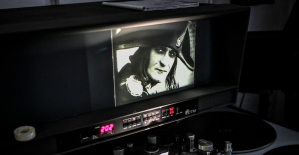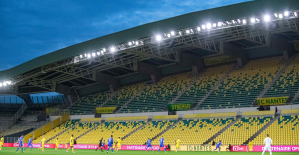It is just getting light when hiking guide José Ignacio Roca and his group reach Lake Sarmiento. Most are still a little sleepy. The trip from Puerto Natales, the backpacker town on the Última Esperanza fjord, started at five in the morning.
But the warning sign at the entrance to Torres del Paine National Park has everyone wide awake. With "potential danger of attack" the wooden sign indicates the presence of cougars on the hiking trail. Roca calmed down immediately: "We don't care about the Pumas at all. We don't belong in their prey scheme."
It quickly becomes clear who the big cats, which can weigh up to 80 kilograms, like to eat instead – guanacos. Again and again you can see the chewed skeletons of the llama-like Andean camels just a few meters from the trail. Fresh puma poop gets the adrenaline pumping even when you're not on the menu.
Roca leads the group through the lonely, rough hilly landscape to a hill. While we marvel at 6,000-year-old cave paintings by the Tehuelche Indians, he looks out for the shy “ghost cats” on the plain. Around 100 cougars live in the zone.
Hardly any other place in South America can you meet as many of the big cats as here. "But of course it's not a zoo. We must be lucky,” Roca clarifies.
It goes on in single file. The cold Patagonian wind bites your face. Large herds of guanaco can be seen again and again. Suddenly, a small group of animals flee.
Roca indicates that everyone should stop and be quiet. The guide searches the bush landscape with binoculars. "There's one," he says, pointing to a distant hilltop. But the Puma is too far away. Not visible to the naked eye. When he passes the binoculars on, the puma has already disappeared.
We see small foxes, ostrich-like Darwin's rheas, even more guanacos and imposing Andean condors with a wingspan of up to three meters. Cougars, however, no longer show themselves that day. Roca presents photos on his mobile phone in which the predators cross the path just meters in front of groups of hikers or lie lazily in the long grass. As if to prove it: you see, you often run into them otherwise.
Seeing the majestic condors in the sky is enough compensation for the missed cougar sighting. And already the next day a new adventure is on the program - the Torres del Paine, the "towers of the blue sky".
The three mighty granite needles, which are up to almost 3000 meters high and to which the national park owes its name, are its landmark. The park in the Chilean part of Patagonia covers an area of 2400 square kilometers and has been a UNESCO World Heritage Site since 1978. Its wild landscape is characterized by turquoise lakes, untouched deciduous forests, snowy mountains, fjords, raging rivers, waterfalls and huge glaciers.
Before the hiking adventure begins, Natalia Gómez and Camila Espinoza, like the other hikers, have to choose between “E” and “W” at the visitor center. “O” is a 130-kilometre circular trail that climbs up to 4,500 meters in eight days. The paths are lonely and far away from any civilization with few shelters, which is why food, sleeping bags and tents have to be taken along.
The two nurses from the capital Santiago de Chile therefore choose the easier “W” route. It is 70 kilometers long and 2,500 meters in altitude have to be conquered in four days. There are fashionable hotels, refuges and campsites with full board on this route, so you don't have to lug around provisions.
The route, which runs on the southern part of the longer "E" loop trail, owes its name "W" to the shape of its course, which leads into the three most scenic valleys of the national park.
The first stage of the day has it all. But it's worth it, because it leads to the Chilean postcard motif par excellence. Up to the Mirador de Las Torres vantage point on the glacial lake below the iconic Torres del Paine rocks, it is a good nine kilometers permanently uphill, almost 1200 meters in altitude. You have to go back along the same path to the "Torre Central" hostel in the immediate vicinity of the visitor center, where the first night is.
Most get up early to see the world-famous slender rock towers in the light of the sunrise. But Natalia and Camila want to take it easy. “As nurses, we have two tough Corona years behind us. We want to relax and enjoy this natural wonder here,” says Natalia.
The serpentine path meanders into the Valle del Silencio, into the "Valley of Silence". Again and again you have to make room for horses that are used to bring provisions to Campamento Chileno. There is a sleeping hut and platforms for tents built on stilts - the perfect place to rest.
Then the more difficult part of the technically but not demanding ascent begins. Above the tree line, the rocky ground makes hiking difficult. A gigantic scree landscape. After a rock edge, the view suddenly opens onto a green glacial lake and the granite needles towering behind it.
They formed more than ten million years ago. Then Ice Age glaciers formed the rock towers, over whose peaks Andean condors often make their rounds. "It was worth the trip to Patagonia just to see that," says Camila. In the evening, the two nurses fall into their bunk beds, exhausted but happy.
The following day's stage will thank God be easier. Without major climbs, it goes through a hilly landscape along the almost kitschy beautiful Lake Nordenskjöld.
On the left the lake, on the right countless waterfalls fall from the steep sloping walls of the Cuernos rock massif above. It bears its name because of the horn shape of the peaks and does not have to hide from the Torres del Paine in terms of visual impact.
We spend the night in green group tents at Camp Francés, right on the shore of Lake Nordenskjöld. In the evening there is lentil soup, stuffed chicken with rice and strudel.
On the third day you have to get up early. Fire red greets the morning sky. After a one-hour hike, we leave our heavy backpacks at the "Italian Camp" (Campamento Italiano) to hike to the Mirador Británico viewpoint with just a daypack. It takes three hours to go up and three hours to go down.
A mighty thunder echoes menacingly through the dark deciduous forests. Not an approaching thunderstorm, but avalanches falling from the glacier resting on the mountaintops. Again and again, almost every ten minutes, huge masses of snow slide down the cliffs and mix with the waterfalls.
The sky above the basin of the Vallée del Francés is threateningly overcast. The ascent finally turns into a climbing party in a scree field. But when you get to the top, all your hard work is forgotten. The mountain scenery with the Cuernos massif is like something out of a picture book. You are enthroned above the seemingly endless Patagonian jungle.
Back at the Campamento Italiano, it's difficult to put on the big backpacks again. we are exhausted But it doesn't help. Camp Paine Grande is almost three hours away and we must reach it before nightfall.
The freezing cold Patagonian south wind whistles in your face again. Waves are already forming on Lake Skottsberg. There are hardly any hikers to be seen. Only lonely, rough nature for hours.
Arriving at Camp Paine Grande, which resembles a gigantic party-heavy youth hostel, is almost a civilization shock. On the terrace, with a "Torres del Paine" beer in hand, you can enjoy the view back to the Cuernos massif, which shimmers mystically. The day ends as it began - with a blood red sky.
The last stage of the day is child's play compared to the day before. Only four hours running time. But nobody can do that. Just like when more and more bright blue ice floes come swimming on the lake of the Gray Glacier, all of which have to be photographed and admired. The closer you get to the glacier, the larger they are.
Finally, you stand in front of a huge wall of ice. The tongue of the glacier is part of the Southern Patagonian Ice Field, the largest sheet of ice in the Southern Hemisphere outside of Antarctica. The Gray Glacier alone is 28 kilometers long. A total of three glacier tongues end here in the lake, they are almost six kilometers wide and 30 meters high. You can also go ice trekking here.
From the Gray campsite you can take the excursion boat to the Hotel Lago Grey. Shuttle buses to Puerto Natales are available here. The boat cruises past the massive walls of ice, which you can admire up close with a Chilean pisco sour in hand. It is a point of honor that the cocktail based on the Chilean national drink is served here with glacier ice.
How to get there: By plane via Santiago de Chile to Punta Arenas or Puerto Natales. From here continue by bus to the national park.
Entry: You need a passport. The Federal Foreign Office provides information on current entry requirements on its website.
Hikes: The eight-day "O" route is relatively demanding. The “W” trekking only takes four days. Both tours require stamina, but no mountaineering experience. Every visitor receives a map at the park entrance. The paths are well marked.
Best travel time: October to May. In the high season between December and February it is not so lonely. That changes abruptly in the off-season.
Accommodation: There are small hotels, shelters and campsites in the park, which serve dinner, breakfast and packed lunches. A reservation is strongly recommended.
Information: Torres del Paine National Park, torresdelpaine.com; Tourist Office Chile, chile.travel/de
Hiking has been experiencing a real boom for a number of years, including among younger people. But hiking can also be dangerous, especially if you want to climb the mountains with the wrong shoes. The right preparation is everything here, too.
Source: WELT/ Peter Haentjes

 Iran-Israel conflict: what we know about the events of the night after the explosions in Isfahan
Iran-Israel conflict: what we know about the events of the night after the explosions in Isfahan Sydney: Assyrian bishop stabbed, conservative TikToker outspoken on Islam
Sydney: Assyrian bishop stabbed, conservative TikToker outspoken on Islam Torrential rains in Dubai: “The event is so intense that we cannot find analogues in our databases”
Torrential rains in Dubai: “The event is so intense that we cannot find analogues in our databases” Rishi Sunak wants a tobacco-free UK
Rishi Sunak wants a tobacco-free UK Alert on the return of whooping cough, a dangerous respiratory infection for babies
Alert on the return of whooping cough, a dangerous respiratory infection for babies Can relaxation, sophrology and meditation help with insomnia?
Can relaxation, sophrology and meditation help with insomnia? WHO concerned about spread of H5N1 avian flu to new species, including humans
WHO concerned about spread of H5N1 avian flu to new species, including humans New generation mosquito nets prove much more effective against malaria
New generation mosquito nets prove much more effective against malaria The A13 motorway closed in both directions for an “indefinite period” between Paris and Normandy
The A13 motorway closed in both directions for an “indefinite period” between Paris and Normandy The commitment to reduce taxes of 2 billion euros for households “will be kept”, assures Gabriel Attal
The commitment to reduce taxes of 2 billion euros for households “will be kept”, assures Gabriel Attal Unemployment insurance: Gabriel Attal leans more towards a tightening of affiliation conditions
Unemployment insurance: Gabriel Attal leans more towards a tightening of affiliation conditions “Shrinkflation”: soon posters on shelves to alert consumers
“Shrinkflation”: soon posters on shelves to alert consumers The restored first part of Abel Gance's Napoléon presented at Cannes Classics
The restored first part of Abel Gance's Napoléon presented at Cannes Classics Sting and Deep Purple once again on the bill at the next Montreux Jazz Festival
Sting and Deep Purple once again on the bill at the next Montreux Jazz Festival Rachida Dati: one hundred days of Culture on the credo of anti-elitism
Rachida Dati: one hundred days of Culture on the credo of anti-elitism The unbearable wait for Marlène Schiappa’s next masterpiece
The unbearable wait for Marlène Schiappa’s next masterpiece Skoda Kodiaq 2024: a 'beast' plug-in hybrid SUV
Skoda Kodiaq 2024: a 'beast' plug-in hybrid SUV Tesla launches a new Model Y with 600 km of autonomy at a "more accessible price"
Tesla launches a new Model Y with 600 km of autonomy at a "more accessible price" The 10 best-selling cars in March 2024 in Spain: sales fall due to Easter
The 10 best-selling cars in March 2024 in Spain: sales fall due to Easter A private jet company buys more than 100 flying cars
A private jet company buys more than 100 flying cars This is how housing prices have changed in Spain in the last decade
This is how housing prices have changed in Spain in the last decade The home mortgage firm drops 10% in January and interest soars to 3.46%
The home mortgage firm drops 10% in January and interest soars to 3.46% The jewel of the Rocío de Nagüeles urbanization: a dream villa in Marbella
The jewel of the Rocío de Nagüeles urbanization: a dream villa in Marbella Rental prices grow by 7.3% in February: where does it go up and where does it go down?
Rental prices grow by 7.3% in February: where does it go up and where does it go down? With the promise of a “real burst of authority”, Gabriel Attal provokes the ire of the opposition
With the promise of a “real burst of authority”, Gabriel Attal provokes the ire of the opposition Europeans: the schedule of debates to follow between now and June 9
Europeans: the schedule of debates to follow between now and June 9 Europeans: “In France, there is a left and there is a right,” assures Bellamy
Europeans: “In France, there is a left and there is a right,” assures Bellamy During the night of the economy, the right points out the budgetary flaws of the macronie
During the night of the economy, the right points out the budgetary flaws of the macronie These French cities that will boycott the World Cup in Qatar
These French cities that will boycott the World Cup in Qatar Champions League: France out of the race for 5th qualifying place
Champions League: France out of the race for 5th qualifying place Ligue 1: at what time and on which channel to watch Nantes-Rennes?
Ligue 1: at what time and on which channel to watch Nantes-Rennes? Marseille-Benfica: 2.99 million viewers watching OM’s victory on M6
Marseille-Benfica: 2.99 million viewers watching OM’s victory on M6 Cycling: Cofidis continues its professional adventure until 2028
Cycling: Cofidis continues its professional adventure until 2028


















